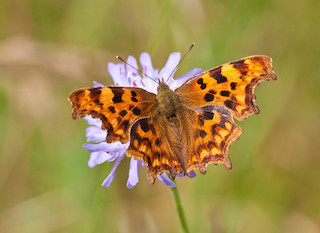The delightful Comma butterfly, with its raggedy wings, can be spotted through the summer months and into early autumn.
Photo: Dougy Wright
Scientific name: Polygonia c-album
Cornish name: ‘Tikki-dui’ is the general word for butterfly
What to look for:
• Colouring: Orange and brown patterned wing uppersides. The undersides are brown.
• Size: Wingspan: 4.5 to 4.8 cm.
• Where: Widespread in the south of England, and expanding northwards.
• When: Throughout the year, including warmer winter days.
• Similar species: Superficially similar to the Small Tortoiseshell, but the wing edges clearly distinguish between the two.
 The wings of this pretty brown and orange butterfly are its most distinctive feature. Some folk would call the wing edges ‘ragged’, but kinder folk call them ‘scalloped’. Whichever you prefer, they make the Comma instantly recognisable. You might have to look harder when it is resting on a leaf with closed wings, though: the dull brown underside and those ragged wings make it look just like a dead leaf.
The wings of this pretty brown and orange butterfly are its most distinctive feature. Some folk would call the wing edges ‘ragged’, but kinder folk call them ‘scalloped’. Whichever you prefer, they make the Comma instantly recognisable. You might have to look harder when it is resting on a leaf with closed wings, though: the dull brown underside and those ragged wings make it look just like a dead leaf.
The Comma is one of our hibernating butterflies, so you may even spot one on warmer winter days, when they might wake up for a few hours. The adults emerge fully from hibernation in March, and there are two generations produced: one in late June/early July, and a second in August and September.
The breeding cycle is an interesting one, in that there are two adult forms. One has darker colouring on the underside of its wings, and hibernates before emerging to reproduce, giving rise to the June/July generation. This generation includes individuals of the darker form (which will go on to overwinter before reproducing), but also a second, lighter, form, which develops straight to sexual maturity, producing the second generation seen in late summer. The proportion of the two forms produced depends on conditions in spring and on photoperiod length when the larvae are developing. Check out the UK Butterflies website for more details.
The fortunes of the Comma over the last two or three centuries have gone up and down, and are now again improving, and in dramatic fashion. Once found as far north as Scotland, by the middle of the eighteenth century the Comma’s only strongholds were in the Welsh borders. From the middle of the twentieth century, however, its range has been expanding significantly once again. This is probably thanks to the clever butterfly changing its favoured caterpillar foodplant. Hops were once a key preference of the various larval foodplants, and the butterfly’s decline corresponded to a decline in hop farming. Then, it switched its preference to Common Nettle, and is now widely distributed in southern England, and increasingly found in Wales and northern England.
Did you know…?
…The Comma gets its common name from the small white comma-shaped mark on the underside of its wings.
More information and references:
Wacher, J., Worth, J. and Spalding, A., 2003. A Cornwall Butterfly Atlas. Pisces Publications, Newbury, Berkshire.
Newland, D., Still, R., Swash, A. and Tomlinson, D., 2002. Britain’s Butterflies. A Field Guide to the Butterflies of Britain and Ireland (third edition). Princeton University Press, Oxfordshire.
Published: September 2016
Author: Amanda Scott
Photos: Homepage, and lower this page: Dougy Wright. Upper this page: ©Natural England/Allan Drewitt
